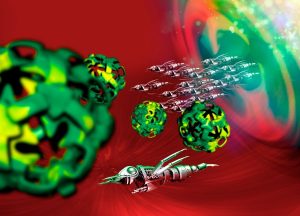Imagine a microscopic machine that could unclog an artery to prevent a heart attack, or swim through one’s blood vessels to carry medicine to a cancerous tumor. Or, perhaps perform delicate vision-saving surgery from the inside of the eye. While these feats aren’t possible yet, researchers are designing miniature robots, or microrobots that may soon do all of the above, and more.
 In today’s world, robots come on a large scale. They can be used in many industries – automotive, agriculture, space exploration, archeology and other disciplines as well. However, the robot’s scientist want to deploy in the human body don’t resemble C-3PO or R2-D2, they are typically less that 1 millimeter (0.04”) in size. At their largest, they might be the size of a few grains of table salt. They can also be much smaller – so small that they can only be seen through the lens of a microscope.
In today’s world, robots come on a large scale. They can be used in many industries – automotive, agriculture, space exploration, archeology and other disciplines as well. However, the robot’s scientist want to deploy in the human body don’t resemble C-3PO or R2-D2, they are typically less that 1 millimeter (0.04”) in size. At their largest, they might be the size of a few grains of table salt. They can also be much smaller – so small that they can only be seen through the lens of a microscope.
The human body is made up mostly of fluids. Blood, spinal fluid, and other liquids make up about 60-65% of the volume of the human body. To move though out this environment with ease, the microrobots must swim. Finding the correct designs and materials to send them swimming though even the tiniest blood vessels has proven challenging, but not impossible. Indeed, over the past decade, scientists are inching their way closer to meet that end.
Before scientists could create these microrobots to swim inside the body, they had to first solve the problem of scale. The physics of swimming changes as an object gets smaller and smaller. That’s because on a microscopic scale, liquids become much more viscous.
David Zarrouk is a professor of mechanical engineering at Ben-Gurion University in Beer-Sheva, Israel. He and his team are building a microrobot that can be used in the intestinal tract. It carries a motor to power its worm-like wiggling. Small electronic sensors inside it collect data on the robot’s precise position in the body. A smooth artificial skin lets the robot snake through the stomach and intestines without damaging them.
The team at Ben-Gurion is using a 3-D printer to build the robot out of plastic. “We try to use soft surfaces that are not going to cause damage”, Zarrouck explains. The reasoning is that the intestines are very flexible.
In China, scientists at the Chinese University of Hong Kong in Shatin, are developing microrobots, or in this case, biohybrids from spirulina, a microscopic plant and food supplement to travel through the body in response to magnetic signals. The biohybrid robot could one day carry drugs to specific parts of the body, minimizing side effects. What’s more, the robot—and its magnetic coat—appear to kill cancer cells.
Magnetic fields created outside the body can penetrate living tissue without harm, allowing researchers to move magnetized objects around inside. For maximum mobility, a helical body propelled by twirling works best. Enter spirulina. “It’s surprising that you can find in nature such a convenient structure and that it can behave so nicely,” says Peer Fischer, a physical chemist at the Max Planck Institute for Intelligent Systems in Stuttgart, Germany, who was not involved in the study.
Directing the fleet of microrobots will take the highest amount of accuracy and technology available. Whether it is powering the worm-like wiggle of the robot being built by Professor Zarrouk, or by the scientists in China, precision is a key component. Employing Universe Optics to design and craft a precision lens will ensure that the equipment specifications will be met with 100% reliability.
There’s still a long way to go for the teams around the world that are developing microrobots. They still need to know that they can carry cargo – such as drugs attached to or within the shapes designed. The goal is to deliver drugs more effectively than just taking a pill or getting an injection. According to So Li Zhang, a materials scientist working with the team in China, “It’s still not ready for a doctor to use,”, but he thinks it might be ready in another 10 years. “Everyone wants to realize this fantastic voyage.”